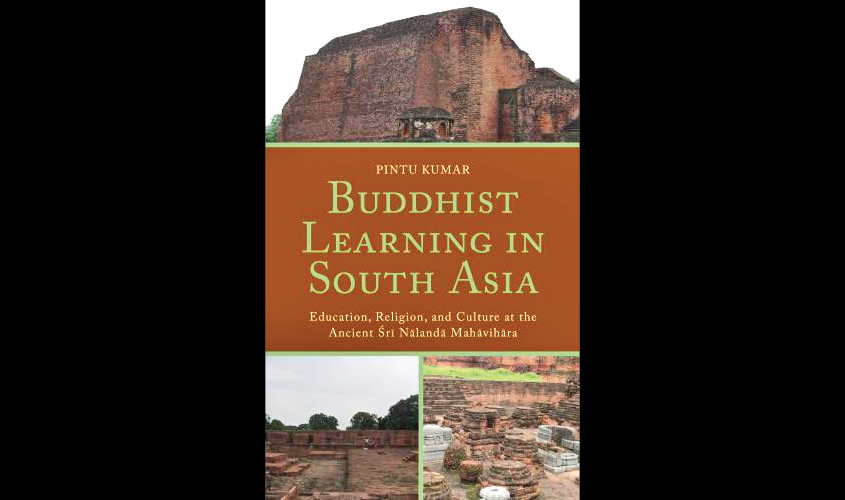A voluminous and timely book published by Dr Pintu Kumar of the Department of History, Motilal Nehru College (Evening), University of Delhi, calls into question some flawed assumptions of fraughtful consequences relating to an important aspect of the early history of Buddhism at the place of its origin (Buddhist Learning in South Asia: Education, Religion, and Culture at the Ancient Sri Nalanda Mahavihara, Lexington Books, 2018). The author moves away from simplistic modern day categorisations of the historic Nalanda Mahavihara in Bihar, either as “half monastery, half university” or more megalomaniac international university — formulations which ascribe modern meanings on an ancient institution for advanced training in Buddhist religion and philosophy. Instead, the setting up and functioning of the large Buddhist monastic institution of learning is studied in terms of its ideological orientation and physical expansion in relation to politics of patronage.
This is an important theme in the history of Buddhism, which has recently acquired topical significance. The richly detailed monograph by Dr Kumar is a must read for those misled by ill-informed assertions in the service of modern politics of religion or secularism with a misplaced sense of pride in the past. The recent attempt to revive the Buddhist Vihara at Nalanda as an International University has run into political difficulties. The assumption that there was an international university at the site functioning through the first millennium CE, and which should be revived in all its glory is no less preposterous.
It has been argued that an international university of worldwide reputation was set up at Nalanda way back in the 5th century and it flourished over the next seven centuries before it was destroyed by a marauding Turkish force led by Bakhtiyar Khalji at the end of the 12th century. The learned Professor Amartya Sen has often suggested that a nine-storied university building serving aspiring international students was attacked by an army of invaders which also devastated many cities on their way to Nalanda. The irony is such a fictitious narrative fits well with the right-wing fabrications of the past, which Professor Sen is seemingly combating. Thus, the revived Nalanda University project can feed the canards on destructions and havoc created by medieval Muslim rulers, with the assertion that this was the time for course correction and even revenge.
The Turkish-Muslim conquest of Punjab, Hindustan and Bengal involved little violence and no dislocation of general population. In Bihar, the army landed up and ransacked a Buddhist monastery without knowing what it was: fortress, Hindu temple, Buddhist monastery or educational institution? By the end of the 12th century, beforeTurkish conquest and forced by Brahmanical reassertion, Buddhism was reduced to some monasteries even in Bihar where it originated. It had to either assimilate itself into a broader Brahmanical-Hindu tradition or relocate to eastern frontiers of Bengal, Myanmar, further east into South-East Asia, besides China and Japan, where inroads were already made for a millennium. Monks and pilgrims from those countries took arduous journeys to visit the places of pilgrimage in Buddhism’s original home. Those important sites and monasteries are now being glorified as international universities. Meanwhile, the tragic history of Buddhism in Bihar has reached its climax with the Census of India reporting that there only 0.02% Buddhists are left in the state today, a mere 25,000 out of a whopping 10 crore.
In this connection, mention may also be made of the horrible violence involving the Rohingya. The current attempt to convert the Rohingya issue into Buddhist-Muslim struggle is an unfortunate spin to long-standing ethnic conflict. The attackers happen to be Buddhist chauvinists unleashing gruesome violence on “Bengali” Rohingya, the majority of whom might have embraced Islam from possible Tantric-Buddhist antecedents—probably originating in early medieval Bihar and undergoing a process of cultural accretion over the past several centuries even as they moved eastward. That ethnic struggle takes a violent religious turn and goes out of control is well reflected in an appalling political position and attitude of the Nobel Peace Prize winner, Aung San Suu Kyi.
As the very sensible Dalai Lama has frequently observed, Buddha would indeed not have approved the kind of violence the world is confronted with today. The abuse of the past in the politics of religion or seeking to revive it, even if for a noble venture, is fraught with all kinds of consequences. In such matters, men in positions of power need to act responsibly and understand that discretion is the better part of valour. Planning to build new institutions of higher education with facilities and infrastructure at par with world-class universities is a commendable idea, but this should not be linked with any symbolic revival of a glorious past without a proper understanding of what that past might have been like.

